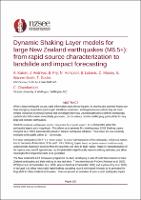| dc.description.abstract | GNS Science has developed a new Shaking Layers tool to rapidly deliver near-real time ground shaking maps for New Zealand, available directly through GeoNet. Shaking Layers combines observed strong motion data with ground motion model predictions to produce maps of PGA, PGV, MMI, Sa(T).
Small-to-moderate earthquakes can be reasonably represented by a ‘point source’, i.e. the hypocentre, or point within the earth where the earthquake began. This allows first shaking maps to be generated automatically and robustly based on earthquake solutions from GeoNet (earthquake magnitude and hypocentre).
For very large earthquakes (M6.5+), a ‘point-source’ is a poor representation of the earthquake, which can rupture tens or hundreds of kilometres of the earth. First shaking models based on ‘point sources’ could severely underestimate shaking in areas close to the fault rupture, but further from the epicentre. If a large earthquake occurs, response seismologists will update Shaking Layers maps with the latest evolving science to improve their accuracy. This could include a 3D finite fault, but also felt reports, a more robust magnitude estimate (Mw) and/or the tectonic type or mechanism of the earthquake.
The R-CET programme (Rapid Characterisation of Earthquake and Tsunami), has also developed and are testing a set of near real-time tools that generate rapid 3D finite fault models. These have the potential to significantly improve shaking estimates, and allow meaningful first impact forecasts (loss and landslide probabilities) to be generated. We present examples of how Shaking Layer maps could evolve based on New Zealand’s largest historical earthquakes. | |

